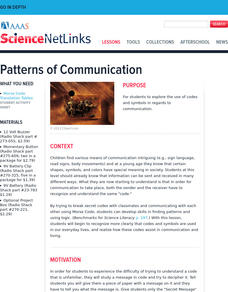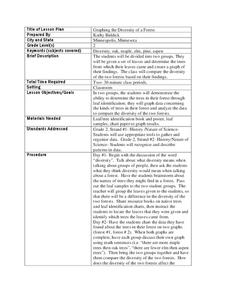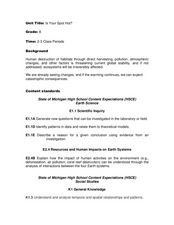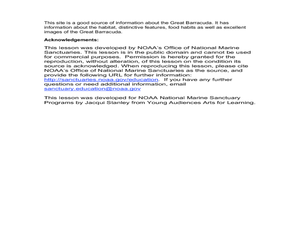Curated OER
Pedigrees
Students examine various inheritance patterns using pedigrees. In groups, they predict what might happen to the offspring of a woman with normal vision and carries the recessive allele gene. They determine the genotypes of the man and...
Curated OER
It's All in the Rings
Students examine how the environment influences tree growth. In this tree instructional activity, students analyze the growth of rings to see how plants adjust to adverse conditions in order to survive.
Curated OER
Water 1: Water and Ice
Young scholars examine the changes as water goes from solid to liquid. In this states of matter lesson, students observe and record the changes to water as it changes from solid to liquid and back to solid.
Curated OER
Sorting
Students understand that sorting helps find things at a later date. In this sorting lesson, students use a website game and sort the common items. Students sort folders and other classroom items. Students discuss how sorting helped them...
Curated OER
The Seasons
Discover the change of the seasons by modeling the Earth-Sun system. Learners model the orbit of the Earth around the sun and explore how and why the patterns of winter and summer occur.
Curated OER
The Mystery of the Missing Hummingbirds
Students record scientific observations in a science journal. In this season instructional activity, students make observations about each of the seasons and record in their journals. Students record organisms response to seasonal...
Curated OER
Climate Change
Ninth graders compare the Arctic and Antarctic. In this climate lesson students work in groups, research and complete an oral report or a poster.
Curated OER
Time Machine: Evolution, Geology
Students are taken on a simulated "voyage" backward in time, to the beginning of our planet. They "witness" that beginning, the origin of life, and a number of key events from then to the present.
Curated OER
Graphing the Diversity of a Forest
Second graders work in groups to identify what types of trees create which types of leaves In this plant life lesson plan, 2nd graders analyze a set of leaves and identify the tree it came from while graphing the data in a science...
Curated OER
Canada's Arctic Barometer
Students research arctic climates. In this Web-quest investigation, students will identify Arctic climate changes, explain the effects of these changes, relate the changes to other regions, and write their findings in a letter format.
Curated OER
Is Your Spot Hot?
Eighth graders explore global warming. In this Earth Science lesson plan, 8th graders will look for Harbingers and fingerprints for different areas. The students will identify an area at risk and they will then create a presentation to...
Curated OER
A Fine Mess
In this enthalpy and entropy worksheet, students read about the differences between enthalpy and entropy and answer three critical thinking questions about the reading.
Curated OER
The Great Barracuda
Young scholars explore oceanography by researching the great barracuda. In this animal life lesson plan, students read several vocabulary terms dealing with ocean life and examine a drawing of a barracuda. Young scholars examine the...
Curated OER
Volume of Gas
Eighth graders investigate the effect of temperature on the volume of a gas in a closed container. They measure the height of the water in their beaker/container, conduct their experiment, and create a graph to illustrate their data.
Curated OER
Pangaea Puzzle: Exploring the Tectonic Forces That Shape the Earth
Sixth graders follow in the footsteps of early scientists as they put the pieces of Pangaea back together and discovered the forces that create the variety of landforms and sea-floor features of our Earth.
Curated OER
Deducing Induction
Students examine how changing magnetic fields induce currents in
loops and coils, determine orientation and magnitude of magnetic field,
describe Michael Faraday's experiments that led to conclusion that changing
magnetic force induces...
Curated OER
The Shape of Things
Sixth graders read and discuss information regarding the shape and attributes of an eggshell. In this shape of things lesson, 6th graders gather relevant information that pertains to the incubation and formation of an eggshell. Students...
Curated OER
Passive Causal Agents and the Omnidirectional Nature of Air Pressure
Students study passive causal agents, such as air pressure, in a system. They conceptualize air pressure as passive and omnidirectional, with molecules that make up the air bouncing off surfaces with which they have contact in all...
Curated OER
Science: The Water Cycle
Students examine the various stages of the water cycle. In groups, they complete a hands-on activity by creating model water cycle. Students design posters representing each of the seven stages of the water cycle.
Curated OER
Eggs'ceptional Experiments
Young scholars see evidence of chemical reaction and follow the scientific method to hypothesize, observe, and reach conclusions. They conduct a series of egg based experiments such as forming crystals and complete journal activities as...
Curated OER
Hurricanes
Young scholars research the formation and life-span of hurricanes and, after analyzing statistics, try their hand at plotting and predicting the course a hurricane.
Curated OER
African Drumming - Repetition of Patterns
Young scholars are introduced to basic patterns used in African drumming. They listen to examples of drumming by Kundidzora Azim, participate in chants and repeat demonstrated rhythms as a class.
Curated OER
From Caterpiller to Butterfly: Cycles, Circles, and Patterns
Students examine art of butterflies and discuss what they know about the insect. They create their own butterfly puppets and write a story to represent its life cycle.
Curated OER
The Best Place in the United States to Live
Students, working in small groups, analyze information provided in U.S. maps to make a logical determination of the best place to live in the United States in regards to natural and human-made hazards. Then, working individually, they...

























